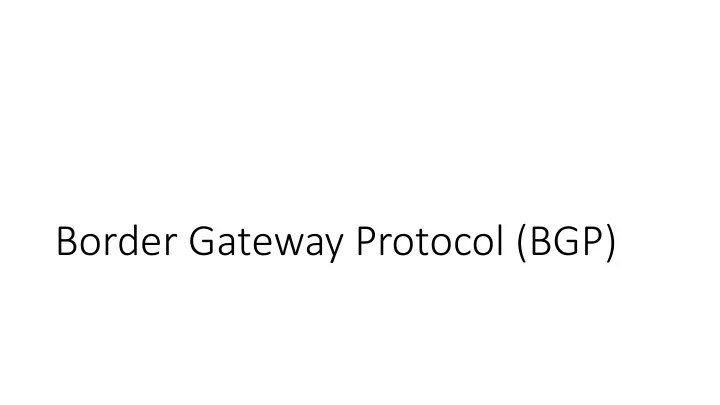

Border Gateway Protocol (BGP)
Structure of the Internet • Networks (ISPs, CDNs, etc.) group with IP prefixes • Networks are richly interconnected, often using IXPs Prefix B1 Prefix D1 Prefix C1 ISP B CDN D IXP CDN C IXP Prefix E1 Prefix A1 Net E IXP IXP Net F ISP A Prefix E2 Prefix A2 Prefix F1
Internet-wide Routing Two requirements not met by simple routing 1. Incorporating policy decisions • Letting parties choose routes to suit their own needs 2. Scaling to very large networks • Prefix aggregation
Effects of Independent Parties • Each party selects routes to ISP A ISP B suit its own interests Prefix A1 Prefix B1 • e.g, shortest path in ISP • What path will be chosen Prefix A2 for A2 à B1 and B1 à A2? Prefix B2 • What is the best path?
Effects of Independent Parties (2) • Selected paths are longer ISP A ISP B than overall shortest path Prefix A1 Prefix B1 • And asymmetric too! • Consequence of independent decisions Prefix A2 Prefix B2
Routing Policies • Capture the goals of different parties • Could be anything • E.g., Internet2 only carries non-commercial traffic • Common policies we’ll look at: • ISPs give TRANSIT service to customers • ISPs give PEER service to each other
Routing Policies – Transit • One party (customer) gets TRANSIT service from another party (ISP) ISP • ISP accepts traffic for customer from Rest of the rest of Internet Internet Customer 1 • ISP sends traffic from customer to the Non- rest of Internet customer Customer 2 • Customer pays ISP for the privilege
Routing Policies – Peer • Both party (ISPs in example) get PEER service from each other ISP A ISP B • Each ISP accepts traffic from the other ISP only for their customers Customer A1 Customer B1 • ISPs do not carry traffic to the rest of the Internet for each other Customer A2 Customer B2 • ISPs don’t pay each other
Routing with BGP • iBGP is used for “internal” routing • eBGP is interdomain routing for the Internet • Path vector, a kind of distance vector Prefix B1 Prefix F1 via ISP ISP B B, Net F at IXP Prefix A1 ISP A IXP Net F Prefix A2 Prefix F1
Routing with BGP (2) • Parties like ISPs are called AS (Autonomous Systems) • AS numbers are unique identifiers • AS’s configure their internal BGP routes • External routes go through complicated filters • Intra-AS BGP routers communicate (via iBGP) to keep consistent routing information
Routing with BGP (3) • Border routers of ASes announce BGP routes • Route announcements have IP prefix, path vector, next hop • Path vector is list of ASes on the way to the prefix • List is to find loops • Route announcements move in the opposite direction to traffic
Routing with BGP (4) Prefix
Routing with BGP (5) Policy is implemented in two ways: 1. Border routers of ISP announce paths only to other parties who may use those paths • Filter out paths others can’t use 2. Border routers select the best path of the ones they hear in any way (not necessarily shortest)
Routing with BGP (6) • TRANSIT : AS1 says [B, (AS1, AS3)], [C, (AS1, AS4)] to AS2
Routing with BGP (7) • CUSTOMER (other side of TRANSIT ): AS2 says [A, (AS2)] to AS1
Routing with BGP (8) • PEER : AS2 says [A, (AS2)] to AS3, AS3 says [B, (AS3)] to AS2
Routing with BGP (9) • AS2 has two routes to B (AS1, AS3) and chooses AS3 (Free!)
BGP “bad gadget”: Non-convergence [2, 0] > [0] > [2, 3, 0] [3, 0] > [0] > [3, 1, 0] [1, 0] > [0] > [1, 2, 0]
BGP slow convergence x [1, 0] 3 1 0 ------ [4, 1, 0] [2, 1, 0] 4 2 [1, 0] [1, 0] ------- ------ [2, 1, 0] [3, 1, 0] [3, 1, 0] [4, 1, 0]
BGP slow convergence x [4, 1, 0] 3 1 0 ---------- [2, 1, 0] 4 2 [2, 1, 0] [3, 1, 0] ---------- ---------- [3, 1, 0] [4, 1, 0]
BGP slow convergence x [4, 2, 1, 0] 3 1 0 4 2 [2, 3, 1, 0] [3, 4, 1, 0]
Implementing policy in BGP 1. Export policy • Determines what to announce to whom 2. Import policy • Determine how to modify (or drop) incoming announcements 3. Decision process • Determine “best” path among all those available
Export policy Arbitrary transformation and filtering of route attributes • Legal transformations for (10.10.10.0/24, [12, 42], [com1, com2]) • (10.10.10.0/24, [12, 24, 93], [com1, com2]) • (10.10.10.0/24, [12, 24, 93, 93, 93, 93], [com1, com2]) • (10.10.10.0/24, [93], [com1, com2]) • (10.10.10.0/24, [12, 24, 93], []) • (10.10.10.0/24, [12, 24, 93], [com1, com32]) In addition, one may aggregate • Only announce, 10.10.0.0/16 • Typically done only if a sub-prefix is present
Import policy Arbitrary transformation and filtering of route attributes And attach a numerical “local preference” attribute
Decision process Standard process (all the mauling happens beforehand) 1. Prefer higher local preference 2. Prefer locally originated routes 3. Prefer shorter AS path 4. Prefer eBGP over iBGP 5. Prefer lower internal cost 6. Prefer lower router ID
Recommend
More recommend